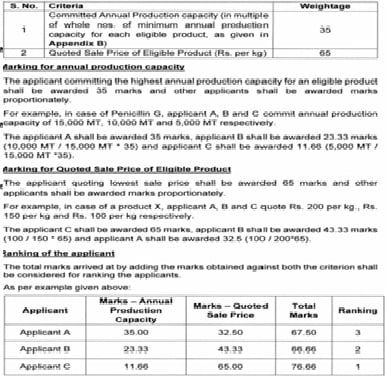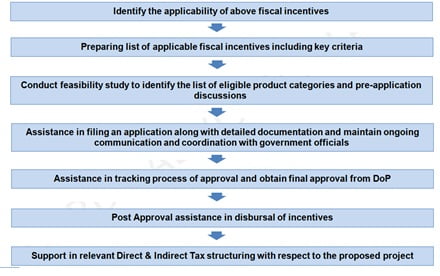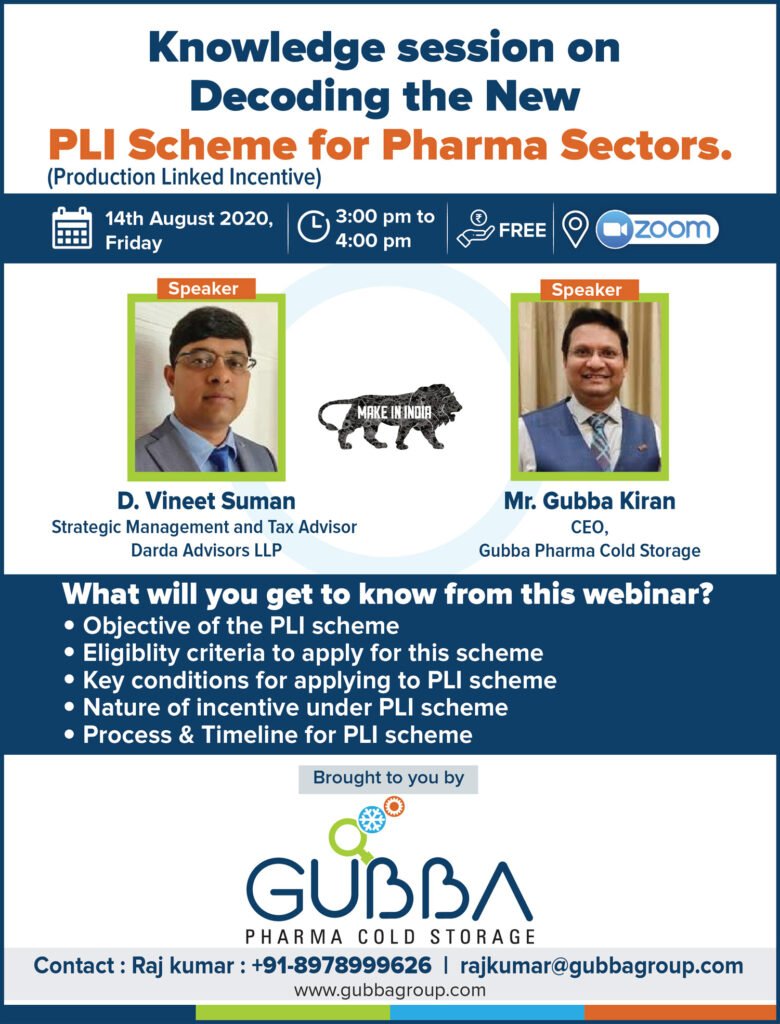Gubba Pharma Cold Storage organized a knowledge session on the Govt. introduced PLI scheme for the pharma industry. The session saw participation from various accountabilities of the pharma companies who got to understand the scheme and its applications in depth.
About the Speaker: Vineet is a qualified Chartered Accountant, Company Secretary and CMA (I) with 15+ years of industry and consulting experience (13+years in Big 4s) in the Tax and Regulatory Services in leadership role. Vineet has worked and currently serving leading players in diverse industry sectors such as Logistic, Auto Component, Financial Services, Pharma, Technology, infrastructure and hospitality, Mining, PSU, Government and other sectors for addressing their concerns under Tax and Regulatory matters.
About PLI scheme:
The Department of Pharmaceutical, Ministry of Chemicals and Fertilizers has issued the notification and the detailed guidelines for Production Linked Incentive (PLI) scheme and bulk drug parks scheme nearly after 4 months of Union cabinet approval for the said schemes in the month of March 2020. The guidelines for the PLI scheme have evoked a mixed reaction from industry stakeholders, associations and experts.
By this article, we are going to decode in detail on who can apply, eligibility criteria, selection criteria, incentive computation and other detail of PLI scheme for Pharma sector.
- Table of Contents
- Objective of the scheme
- Incentive under the scheme
- Who can apply?
- Tenure of the scheme and validity
- Eligibility criteria
- Selection criteria
- Other Key aspects
- Incentive computation
- Steps to apply for PLI Scheme
- How to get incentive?
- Challenges under PLI scheme
- How our partner Darda Advisors LLP can assist you!
Objective of the scheme:
The scheme intends to boost domestic manufacturing of critical KSMs/DI/API by attracting large investments in the sector and thereby reduce India’s import dependence in critical APIs
Incentive under the scheme:
- For Fermentation based eligible products (% of incremental Sales)
- First Four Years – 20%
- Fifth Year – 15%
- Sixth Year – 5%Relevant period – FY 2023-24 to FY 2028-29 (6 years)
-
For Chemically Synthesis Eligible Product – 10% of incremental Sales for six years
Relevant period – FY 2022-23 – FY 2027-28 (6 years)
Base Year – FY 2019-20
Kindly refer detail about the eligible products, incentive limit, and limit on number of applications in PLI guidelines available on: https://pharmaceuticals.gov.in/
Who can apply?
Any Proprietary Firm or Partnership Firm or Limited Liability Partnership (LLP) or a Company registered in India proposing to manufacture eligible products. The applicant shall invest threshold investment in any Greenfield Project.
Tenure of the scheme and validity:
Tenure of the scheme – FY 2020-21 to FY 2029-30 (10 years)
Time line to file application is 120 days from the date of issuance of guidelines i.e. 27 July 2020. Last date 24 November 2020
Eligibility criteria:
Any applicant who wishes to apply for the scheme needs to satisfy following conditions which we have discussed in detail herewith:
• Manufacturers of critical KSM/DI/API registered in India
• Minimum threshold investment – Rs. 20 – 400 crores
• Domestic Value Addition shall be at least 90% in case of fermentation based product and at least 70% in the case of chemical synthesis based product
• Net worth of the applicant (including of Group companies) should not be less than 30% of the total proposed investment – Mandatory
• Not declared as bankrupt or willful defaulter or defaulter or reported as fraud by any Bank /FI/NBFC
• Greenfield Project only
• Sold/Supplied directly to a Domestic Manufacturers only
• Maximum number of applicants per eligible product is limited to in the range of 2 to 4 [Total 136 applications]
Key aspects of the above conditions are discussed in detail:
The threshold investment computation is to be done based on below parameter:
INVESTMENT covers
Expenditure incurred on New:
• Plant,
• Machinery,
• Equipment including laboratory equipment, and
• Associated utilities
[Include expenditure on packaging, freight, transport, insurance, and erection and commissioning]
Capital Expenditure incurred for setting up New Research and Development facility and product development for eligible product
Expenditure incurred on Building
Building includes:
expenditure on construction of building where new plant and machinery are installed, and
Associated infrastructure including internal roads and compound wall. [Limited to 20% of the investment in new plant & machinery]
And excludes
Guest house building,
Recreational facilities,
Office building,
Residential colonies and similar structures
Associated utilities would include following essential equipment:
Clean Rooms,
Air Curtains,
Temperature and Air Quality Control Systems,
Compressed Air, Water & Power Supply and Control Systems.
ETP,
Incinerators, Effluent lines tanks / treatment,
Supply lines of water / sewerage / solvents / gases, solvent recovery, solid waste treatment plant,
Solvent storage tanks,
LPG storage tanks,
Warehousing,
Electricity lines,
Power generation facility and
Communication lines for telephone/internet within the establishment.
Note:
All non-creditable taxes and duties would be included in such expenditure except building
Expenditure incurred on Land shall not be considered for threshold investment
No second hand/used/refurbished plant, machinery, equipment, utilities or R&D equipment shall be used to manufacture the eligible product
Domestic Value Addition: Applicant is required to furnish computation of Domestic Value Addition (DVA) supported by detail of cost of production, key raw material (variety, specifications, and quantity), consumables and process with cost sheet and source of procurement (import & Domestic)
Domestic Value Addition shall be computed as:
Net sales turnover minus value of non-originating material
And services used in manufacturing of eligible product/
_________________________________
Net sales turnover
Net worth comprises:
• Paid-up Capital
• Free Reserves including Share Premium but excluding Revaluation Reserves,
• Investment Fluctuation Reserve and
• credit balance in Profit & Loss account,
Less
• debit balance in Profit & Loss account,
• Accumulated Losses and
• Intangible Assets
Greenfield Project: Project(s) wherein investment equal to or more than threshold investment is proposed to be made by the applicant under this Scheme in a new production facility or in a new plant in the premises of an existing production facility. Separate records shall however be maintained for the new plant(s) in the premises of an existing production facility for the purpose of the Scheme.
Note: If the applicant proposes to set-up a new plant in premises of an existing production facility, the applicant may utilise existing ancillary facilities viz. ETP, quality control lab, warehousing area and other facilities of the existing production facility, for the manufacture of eligible product. However, the investment already made in the ancillary facilities shall not qualify for the purpose of the threshold investment to be made under the Scheme.
Selection criteria:
• All eligible applicants shall be ranked on the basis of marks obtained in the evaluation criteria

• The applicant securing highest marks shall be ranked 1, followed by applicant securing second highest marks and so on
• The selection of the applicants shall be in the order of their ranks
• The number of selected applicants shall be limited by the maximum amount of incentive available for each eligible product (Refer Annexure C)
• In case, two or more applicants have same score, the selection shall be made on the basis of the scores obtained against the criterion, “sale price for incentive quoted in the application.”
• In case the applicants have same score in this criterion also, the applicant whose application is received earlier shall be selected. For this purpose, the date of submission of original application shall be considered. “FIRST COME FIRST SERVED BASIS”
• CPSE under the administrative control of DoP, will get priority in the national interest
Selection Criteria – Example:
Scenario — I
In case of Penicillin G, if the applicants securing Rank 1 and Rank 2 have committed annual production capacity of 10,000 MT and 5,000 MT respectively, then only applicant securing Rank 1 will be selected and applicant securing Rank 2 will not be selected. In this scenario, applicant securing Rank 1 will be eligible for incentive on 10,000 MT annual production capacities.
Scenario – 2
In case of Penicillin G, if the applicants securing Rank 1 and Rank 2 have committed annual production capacity of 5,000 MT and 10,000 MT respectively, then both the applicants will be selected. However, for both the selected applicants, incentive shall be available for 5000 MT capacity only. However, in case a lower ranking applicant has quoted sale price lower than that of applicant securing Rank 2, then the applicant securing Rank 2 shall be required to install committed capacity of 10,000 MT and make corresponding committed investment.
Other Key aspects:
• An applicant can apply for more than one eligible product. However, a separate application along with the application fee is required to be submitted for each eligible product
• An applicant may commit annual production capacity higher than the minimum annual production capacity. However, the capacity committed shall be in whole number multiple of the minimum annual production capacity, along with commitment to invest corresponding multiple of threshold investment
• Considering the time taken for establishment of manufacturing facility, complexity of the manufacturing process involved and requirement of regulatory approvals, a gestation period of:
2 years (FY 2021-22 and FY 2022-23) is provided for eligible products manufactured by fermentation process and
1 year (FY 202 1-22) for eligible products manufactured by chemical synthesis.
• Eligibility under the scheme shall not affect eligibility under any other scheme and vice-versa
• Eligibility for the incentive covers:
• Both the eligibility criteria of threshold investment and minimum annual production capacity to be met for each of the eligible products
• In case, the committed annual production capacity and corresponding investment committed is more than minimum annual production capacity and threshold investment, the selected applicant shall have to complete the installation of committed annual production capacity and make committed investment, as stated in the approval letter, in order to be eligible to claim incentive
• To achieve minimum stipulated DVA for a claim period in order to remain eligible for receiving incentive for that claim period, subject to following relaxation:
Fermentation based product 80% to 90%
Chemical synthesis based product 60% to 70%
• If above relaxation is adopted by the applicant, the applicant will get 50% of the eligible incentive and would be available for a period of 12 months only (one claim period of 12 months or any two claim periods of 6 months) during the tenure of the Scheme
Incentive computation
• The incentive applicable for a selected applicant shall be computed as follows:
Net Sales (Domestic) of Eligible Product x Rate of Incentive
• The sale price quoted in the application form shall be maximum price on which applicant can claim incentive and shall remain fixed throughout the tenure of the Scheme. However, it is clarified that price quoted by the applicant is only for calculation of incentive and there are no conditions and restrictions under these guidelines on the actual sale price of the eligible product
• In case of in-house consumption of eligible product by the selected applicant, the net sales of eligible product shall mean the actual cost of production of the said product
• All approved applicants shall be required to furnish self-certified QRR within 30 days from the end of each quarter
Steps to apply for PLI Scheme
• Identify the product/Products for which application needs to be filed
• Identify the competitors who are going to file the application for similar product
• Evaluate satisfaction of key eligibility conditions
• Net worth basis formula under policy for the Group as a whole, whether satisfied or not
• Project backend supply chain domestic procurement strategy and output sales in domestic market
• Non-refundable fee to be paid whether selected or not
• Estimation of threshold investment for each aspect including detailed break up
• Quoted sale price of the product’s estimation
• Revenue (exports and domestic) and employment generation’s estimation
• Domestic value addition detailed computation and cost disclosure
• Detailed project report with techno-economic viability of the project
• Information on licenses, permits and third-party approvals necessary to execute the project and proposed process and timelines for obtaining clearances
• Project implementation plan
• List of legal or financial cases pending against the applicant
• Multiple certificates from CA/CMA/CS/CE
• Financial closure

Challenges under PLI scheme:
• Online portal launched but non operational for applying online
• Whether incentive would be granted in case actual production capacity is lower than estimated production capacity due to market and other reasons
• Discretion of PMA/EC can leads to rejection of application who have higher credibility or weightage
• Investment to be made in multiples of the minimum annual production capacity
• Investment gestation period of 2/1 years is not adequate considering current epidemic situation
• Bank guarantee of 1% of committed investment if selected [To be invoked if investment not made at least 10-90% within 180-720 days]
• Domestic Value addition to be proved at the time of filing and for every disbursement
How our partner Darda Advisors LLP can assist you!
Being the scheme is limited in terms of number of application, time line and eligibility conditions, its utmost important to have adequate assistance and support to deliberate and accordingly prepare the application and apply to obtain the approval. Our Partner Darda Advisors LLP have team of experienced professional handling such type of engagements for various sectors and can assist you covering following aspects:

You can reach out to them directly on 91-99529 26239 or email [email protected] or write to us.
Meanwhile, China’s dominance in bulk drugs is due to the regulatory and infrastructure support it gets from its government, which includes common facilities across plants and various subsidies and drawbacks etc, assisting the industry to cut the cost considerably. Now, with similar support to Indian Bulk drugs manufacturers, India too got a chance to become a leader in manufacturing pharmaceuticals, fulfilling its own requirements and exporting it to the world – Make in India, Make for World!!!.
Written and edited by:
D.Vineet Suman
Co-founder and Managing Partner, Darda Advisors LLP
91-99529 26239 or email [email protected]


